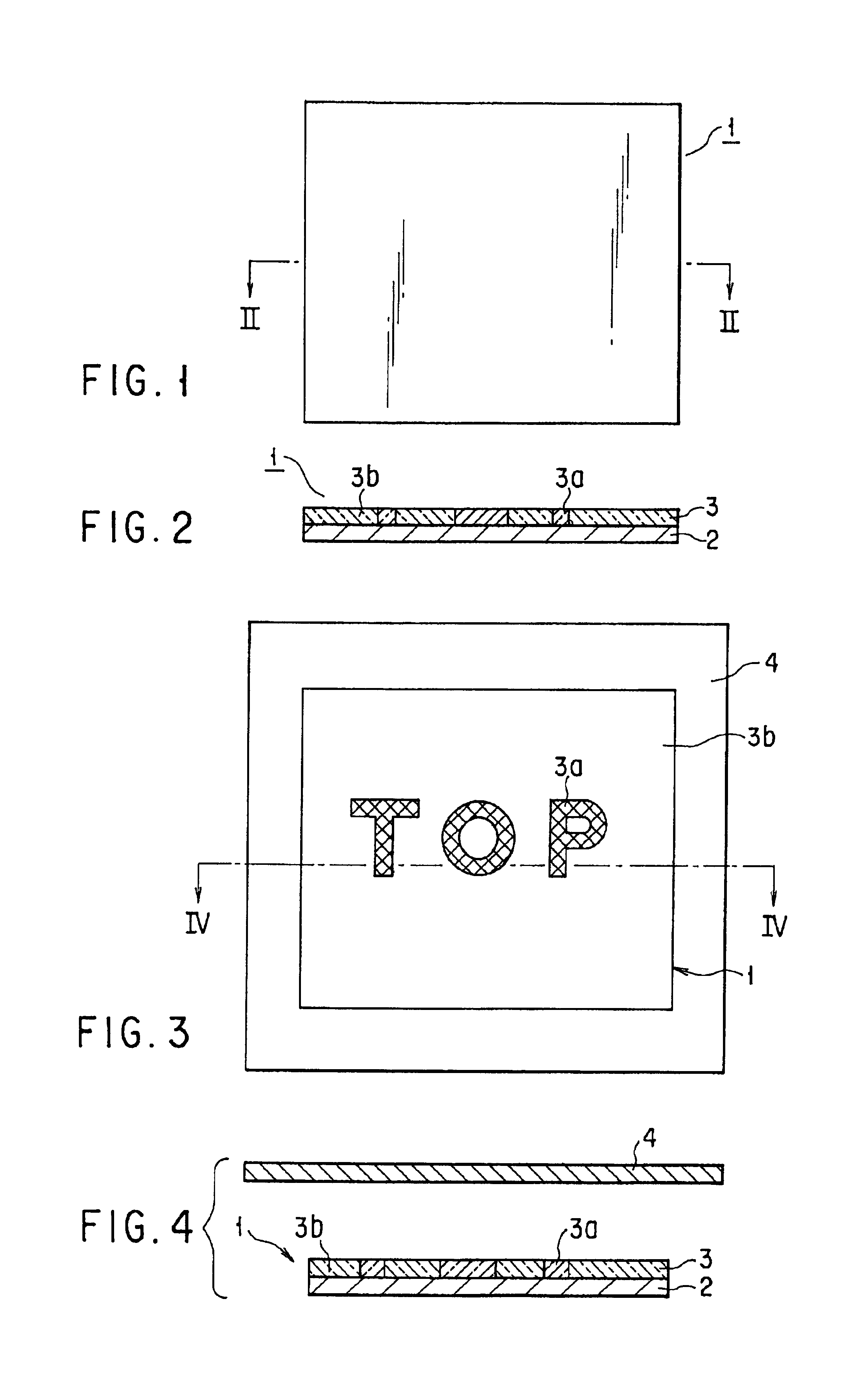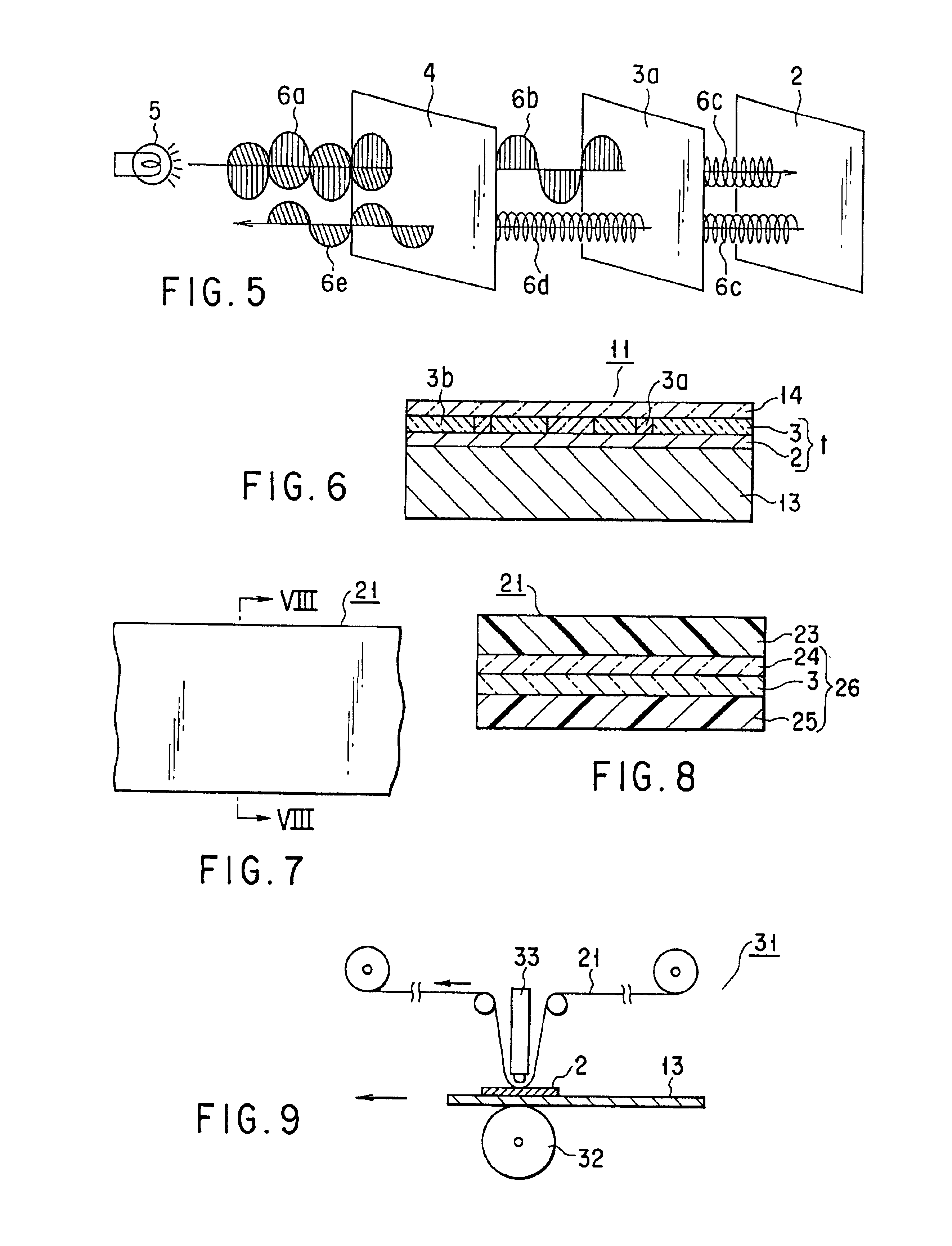Laminated composite, information recording medium, and member of imparting forgery-preventing characteristic
- Summary
- Abstract
- Description
- Claims
- Application Information
AI Technical Summary
Benefits of technology
Problems solved by technology
Method used
Image
Examples
example 1
[0167]The information recording medium 11 shown in FIG. 6 was manufactured by the following method. First, a metal layer of about 60 nm thick was formed as a specular reflection layer 2 by a vacuum evaporation method on one of the main surfaces of a polyethylene terephthalrate (PET) substrate 13 of 50 μm thick. Second, on the specular reflection layer 2, a latent image formation layer 3 was formed by a gravure method using a coating liquid for a latent-image formation layer having a composition shown below. Note that the temperature for drying was 60° C. and coating thickness was 0.5 μm.
[0168]Composition of the coating liquid for a latent image formation layer
[0169]
Liquid crystalline polymer:20 parts by weight[Chiracoal PLC-7003 manufactured by Asahi DenkaKogyo K.K.]MEK:80 parts by weight
[0170]Thereafter, an FDS medium TP (manufactured by Toyo Ink Manufacturing Co., Ltd.) was print-coated, as an anchor medium, on the latent image formation layer 3 with a thickness of about 1 μm by a...
example 2
[0173]An information recording medium 11 was manufactured in the same manner as Example 1 except that a latent image was formed by thermal head printing in place of hot stamping. When the information recording medium 11 having a latent image thus formed was visually observed, the latent image could not be recognized and the medium 11 looked as a mere metal deposited medium. In contrast, when the information recording medium 11 was observed through a circularly polarizing film 4, the latent image was clearly observed as a visible image regardless of observation angle. In this example, since the latent image was formed by thermal head printing, any pattern of the latent image could be formed.
example 3
[0174]The adhesive-backed sheet 21 shown in FIGS. 7 and 8 was manufactured by the following method. An information recording medium 11 shown in FIGS. 11 and 12 was manufactured by using the sheet 21.
[0175]A releasable protection layer 24 of about 1.0 μm thick was formed on one of the major surfaces of a transparent PET base 23 of 12 μm thick by a gravure method using a coating liquid for a releasable protection layer having the composition shown below.
[0176]Composition of the coating liquid for releasable protection layer
[0177]
Acrylic resin:20 parts by weight[BR-80 manufactured byMitsubishi Rayon Co., Ltd.]Toluene:40 parts by weightMEK:35 parts by weightEthyl acetate: 5 parts by weight
[0178]Next, on the releasable protection layer 24, a latent image formation layer 3 was formed by a gravure method using a coating liquid for a latent image formation layer having the composition shown below. The temperature for drying was 60° C. and the coating thickness was 0.5 μm.
[0179]Composition o...
PUM
| Property | Measurement | Unit |
|---|---|---|
| Length | aaaaa | aaaaa |
| Percent by mass | aaaaa | aaaaa |
| Percent by mass | aaaaa | aaaaa |
Abstract
Description
Claims
Application Information
 Login to View More
Login to View More - R&D
- Intellectual Property
- Life Sciences
- Materials
- Tech Scout
- Unparalleled Data Quality
- Higher Quality Content
- 60% Fewer Hallucinations
Browse by: Latest US Patents, China's latest patents, Technical Efficacy Thesaurus, Application Domain, Technology Topic, Popular Technical Reports.
© 2025 PatSnap. All rights reserved.Legal|Privacy policy|Modern Slavery Act Transparency Statement|Sitemap|About US| Contact US: help@patsnap.com



